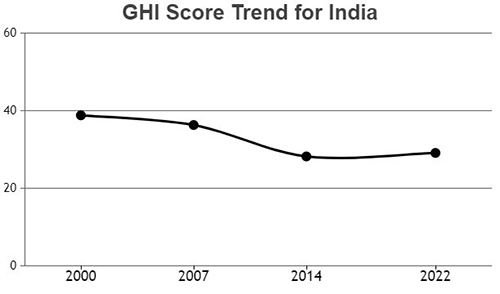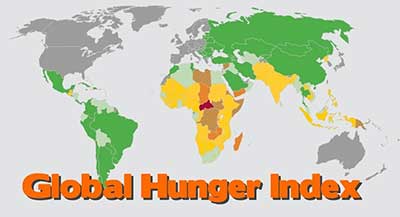Date: 17/10/2022
Relevance: GS-2: Issues relating to the development and management of Social Sector/Services relating to Health, Education, Human Resources.
Key Phrases: Global Hunger Index, International Food Policy Research, Child wasting, Child stunting, Child mortality, National Nutrition Mission, Poshan Abhiyaan, Zero Hunger Programme, Sustainable food production, Eat Right India Movement, Mid-Day Meal Scheme, Integrated Child Development Services, Supplementary nutrition.
Why in News?
- India's rank in the Global Hunger Index has consistently worsened in the last 10 years. The country's rank has become quite poor since 2016.
Global Hunger Index:
- Created in 2006, the GHI was initially published by the US-based International Food Policy Research Institute (IFPRI) and Germany-based Welthungerhilfe.
- In 2007, the Irish NGO Concern Worldwide also became a co-publisher. In 2018, IFPRI stepped aside from its involvement in the project and the GHI became a joint project of Welthungerhilfe and Concern Worldwide.
- The Global Hunger Index (GHI) is a tool for comprehensively measuring and tracking hunger at global, regional, and national levels.
- GHI scores are based on the values of four component indicators:
- Undernourishment (share of the population with insufficient caloric intake);
- Child wasting (share of children under age five who have low weight for their height, reflecting acute under nutrition);
- Child stunting (share of children under age five who have low height for their age, reflecting chronic under nutrition);
- Child mortality (mortality rate of children under age five, partly reflecting the fatal mix of inadequate nutrition and unhealthy environments).
- Based on the values of the four indicators, the GHI determines hunger on a 100-point scale where 0 is the best possible score (no hunger) and 100 is the worst. Each country’s GHI score is classified by severity, from low to extremely alarming.
Key Finding of Global Hunger Index 2022:
- Ranks in South Asia:
- India ranks 107 out of 121 countries on the Global Hunger Index in which it fares worse than all countries in South Asia barring war-torn Afghanistan.
- India also ranks below Sri Lanka (64), Nepal (81), Bangladesh (84), and Pakistan (99). Afghanistan (109) is the only country in South Asia that performs worse than India on the index.
- Child wasting rate:
- India’s child wasting rate (low weight for height), at 19.3%, is worse than the levels recorded in 2014 (15.1%) and even 2000 (17.15%), and is the highest for any country in the world and drives up the region’s average owing to India’s large population.
- Prevalence of undernourishment
- Prevalence of undernourishment has also risen in the country from 14.6% in 2018-2020 to 16.3% in 2019-2021. This translates into 224.3 million people in India considered undernourished out of the total 828 million people undernourished globally.
- Child stunting and child mortality:
- India has shown improvement in these two indicators.
- Child stunting has declined from 38.7% to 35.5% between 2014 and 2022,
- Child mortality has also dropped from 4.6% to 3.3% in between 2014 and 2022.

- Worsening GHI score:
- On the whole, India has shown a slight worsening with its GHI score increasing from 28.2 in 2014 to 29.1 in 2022. Though the GHI is an annual report, the rankings are not comparable across different years. The GHI score for 2022 can only be compared with scores for 2000, 2007 and 2014.

Some of the Initiatives taken by India to battle hunger:
- National Nutrition Mission
- India’s Prime Minister launched the National Nutrition Mission (NNM) or the Poshan Abhiyaan with the goal of attaining “Kuposhan Mukt Bharat” on International Women’s Day 2018.
- The aim of the mission is to remove malnutrition from the country by 2022.
- It aims to improve the nutritional health of children, adolescents, lactating mothers and pregnant women.
- It targets children, anaemia (among young children, women and adolescents), low birth weight, undernutrition.
- Zero Hunger Programme
- The Zero Hunger programme was launched on October 16, 2017. The day is marked as ‘World Food Day.
- It focuses on nutrition, health and agriculture. It was initiated by joint collaboration of the Indian Council of Agriculture Research (ICAR), the Indian Council of Medical Research (ICMR), MS Swaminathan Industry Research Assistance Council (BIRAC).
- The aim of the programme is
- Double the agriculture productivity and income of small scale farmers
- Eliminate the wastage of the food
- Ensuring the sustainable food production system and access to food all around the world.
- Decrease the child stunting for children 2 years and younger etc.
- Eat Right India Movement
- The Eat Right India Movement is an initiative of the government of India.
- The Safety and Standard Authority of India (FSSAI) to transform the country’s food system in order to ensure safe, healthy and sustainable food for all Indians. This scheme was launched in 2018.
- The goal was ‘Sahi Bhojan, Behtar Jeevan’.
- Mid-Day Meal Scheme
- Mid-Day Meal Scheme was started on August 15, 1995, under the programme of National Support to Primary Education.
- In September 2021 it was renamed PM Poshan. It aims to provide food to all the children enrolled in government-aided schools, local body schools, and special training centers.
- The main objectives of the MDM scheme are:
- To increase the enrolment of the children belonging to the disadvantaged sections in the schools.
- To provide nutritional support to the children of the elementary stage in drought-affected areas.
- Integrated Child Development Services:
- Launched on 2nd October, 1975, Integrated Child Development Services (ICDS) is the only major national program that addresses the needs of children under the age of six years.
- It seeks to provide young children with an integrated package of services such as supplementary nutrition, health care and pre-school education.
Source: Down To Earth
Mains Question:
Q. ‘Poverty and Hunger reduction Programmes in India remain mere show pieces until and unless they are backed by political will’. Discuss with reference to the performance of India in the Global Hunger Index over the years.








